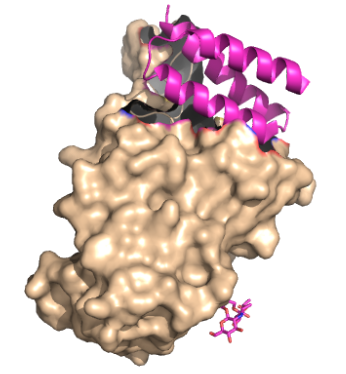Sandbox Reserved 1847
From Proteopedia
(Difference between revisions)
| Line 3: | Line 3: | ||
==Introduction== | ==Introduction== | ||
===What are Minibinders?=== | ===What are Minibinders?=== | ||
| - | Minibinders are small proteins that bind to the spike protein that is involved in the viral infection pathway for SARS-CoV-2. These mini proteins target the interaction between SARS-CoV-2 spike protein and ACE2 receptor as an effective therapeutic strategy <ref name="Longxing">PMID:34192518</ref>. The demand for SARS-CoV-2 therapeutics is high, and the promise these minibinders have shown is | + | Minibinders are small proteins that bind to the spike protein that is involved in the viral infection pathway for SARS-CoV-2. These mini proteins target the interaction between SARS-CoV-2 spike protein and ACE2 receptor as an effective therapeutic strategy <ref name="Longxing">PMID:34192518</ref>. The demand for SARS-CoV-2 therapeutics is high, and the promise these minibinders have shown is substantial. These minibinders were able to reduce the viral burden of SARS-CoV-2 in mice <ref name="Case">PMID:33688650</ref>. These proteins were de novo (from scratch) designs to mimic the ACE2 helix, but |
===COVID-19 Viral Infection Interruption=== | ===COVID-19 Viral Infection Interruption=== | ||
==Subheading 2== | ==Subheading 2== | ||
Revision as of 19:03, 27 March 2025
| This Sandbox is Reserved from March 18 through September 1, 2025 for use in the course CH462 Biochemistry II taught by R. Jeremy Johnson and Mark Macbeth at the Butler University, Indianapolis, USA. This reservation includes Sandbox Reserved 1828 through Sandbox Reserved 1846. |
To get started:
More help: Help:Editing |
Contents |
Structure
Introduction
What are Minibinders?
Minibinders are small proteins that bind to the spike protein that is involved in the viral infection pathway for SARS-CoV-2. These mini proteins target the interaction between SARS-CoV-2 spike protein and ACE2 receptor as an effective therapeutic strategy [1]. The demand for SARS-CoV-2 therapeutics is high, and the promise these minibinders have shown is substantial. These minibinders were able to reduce the viral burden of SARS-CoV-2 in mice [2]. These proteins were de novo (from scratch) designs to mimic the ACE2 helix, but
COVID-19 Viral Infection Interruption
Subheading 2
| |||||||||||
References
- ↑ 1.0 1.1 Case JB, Chen RE, Cao L, Ying B, Winkler ES, Johnson M, Goreshnik I, Pham MN, Shrihari S, Kafai NM, Bailey AL, Xie X, Shi PY, Ravichandran R, Carter L, Stewart L, Baker D, Diamond MS. Ultrapotent miniproteins targeting the SARS-CoV-2 receptor-binding domain protect against infection and disease. Cell Host Microbe. 2021 Jul 14;29(7):1151-1161.e5. PMID:34192518 doi:10.1016/j.chom.2021.06.008
- ↑ Case JB, Chen RE, Cao L, Ying B, Winkler ES, Goreshnik I, Shrihari S, Kafai NM, Bailey AL, Xie X, Shi PY, Ravichandran R, Carter L, Stewart L, Baker D, Diamond MS. Ultrapotent miniproteins targeting the receptor-binding domain protect against SARS-CoV-2 infection and disease in mice. bioRxiv [Preprint]. 2021 Mar 1:2021.03.01.433110. PMID:33688650 doi:10.1101/2021.03.01.433110
- ↑ Hanson, R. M., Prilusky, J., Renjian, Z., Nakane, T. and Sussman, J. L. (2013), JSmol and the Next-Generation Web-Based Representation of 3D Molecular Structure as Applied to Proteopedia. Isr. J. Chem., 53:207-216. doi:http://dx.doi.org/10.1002/ijch.201300024
- ↑ Herraez A. Biomolecules in the computer: Jmol to the rescue. Biochem Mol Biol Educ. 2006 Jul;34(4):255-61. doi: 10.1002/bmb.2006.494034042644. PMID:21638687 doi:10.1002/bmb.2006.494034042644

